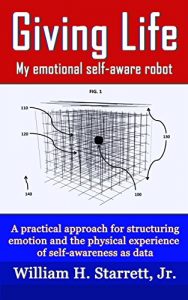Can computers and robots feel and experience emotion?
American software developer and entrepreneur William H. Starrett, Jr. shows how sentient computing environments are not only possible, his recent patent filing may hold a long awaited key toward emotionally self-aware computers and robots with developed personalities.
Starrett explains, "As a programmer, I was designing one particular stock index trading system that involved artificial intelligence to forecast changes in market condition. That research with neural networks and machine learning algorithms led to other ideas. Mixed with recollections of personal experiences and topics that I have studied over the years, I eventually realized how easy it would be to model the human subjective experience virtually and give software or a robot a way to feel what it's like to be alive dynamically within its algorithmic space."
Giving Life: My emotional self-aware robot reveals an early draft of the Starrett model for designing programmatic emotional experiences - an approach that could have far-reaching implications for technological advancements in entertainment, science, business, and industry.
You will see how, instead of computing environments being limited to identifying rudimentary facial expressions and symbolic ideas of emotion from an observer's point of view, Starrett's patent filing depicts systems and methods for creating software that models the physical sensations of emotion first person and a path for programmatically relating to the abstractions of self-awareness with the immersive perception of feelings similar to how we humans do.
Starrett admits, "Obviously, creators of devices that perform from a self-contemplating experience simular to how our ideas emerge from inside of our human self-awareness will encounter some level of controversy. There are benefits and risks with computers or robots being allowed to experience empathy or intuition. Clearly, I wouldn't want your cell phone making passionate decisions. I don't particularly want my television, car, or web enabled toaster to suffer from depression or feel stressed out."
In the book Giving Life: My emotional self-aware robot, William Starrett details early results from his work and why reaching this major technological milestone has been delayed. While many leading researchers warn how self-experiencing computing environments will arrive almost magically, far off into the future, when hardware reaches levels of architecture more complex, Starrett's approach seems far more pragmatic and brings them immediately within reach. By using data from an experience of self-awareness in various types of decision models, Starrett concludes that some technologies could drastically improve and these unknown advancements desperately need to be explored.
Reserve your copy of Giving Life: My emotional self-aware robot by William H. Starrett, Jr. today.
Proceeds earned from book sales help further emotive modeling and artificial intelligence research.
American software developer and entrepreneur William H. Starrett, Jr. shows how sentient computing environments are not only possible, his recent patent filing may hold a long awaited key toward emotionally self-aware computers and robots with developed personalities.
Starrett explains, "As a programmer, I was designing one particular stock index trading system that involved artificial intelligence to forecast changes in market condition. That research with neural networks and machine learning algorithms led to other ideas. Mixed with recollections of personal experiences and topics that I have studied over the years, I eventually realized how easy it would be to model the human subjective experience virtually and give software or a robot a way to feel what it's like to be alive dynamically within its algorithmic space."
Giving Life: My emotional self-aware robot reveals an early draft of the Starrett model for designing programmatic emotional experiences - an approach that could have far-reaching implications for technological advancements in entertainment, science, business, and industry.
You will see how, instead of computing environments being limited to identifying rudimentary facial expressions and symbolic ideas of emotion from an observer's point of view, Starrett's patent filing depicts systems and methods for creating software that models the physical sensations of emotion first person and a path for programmatically relating to the abstractions of self-awareness with the immersive perception of feelings similar to how we humans do.
Starrett admits, "Obviously, creators of devices that perform from a self-contemplating experience simular to how our ideas emerge from inside of our human self-awareness will encounter some level of controversy. There are benefits and risks with computers or robots being allowed to experience empathy or intuition. Clearly, I wouldn't want your cell phone making passionate decisions. I don't particularly want my television, car, or web enabled toaster to suffer from depression or feel stressed out."
In the book Giving Life: My emotional self-aware robot, William Starrett details early results from his work and why reaching this major technological milestone has been delayed. While many leading researchers warn how self-experiencing computing environments will arrive almost magically, far off into the future, when hardware reaches levels of architecture more complex, Starrett's approach seems far more pragmatic and brings them immediately within reach. By using data from an experience of self-awareness in various types of decision models, Starrett concludes that some technologies could drastically improve and these unknown advancements desperately need to be explored.
Reserve your copy of Giving Life: My emotional self-aware robot by William H. Starrett, Jr. today.
Proceeds earned from book sales help further emotive modeling and artificial intelligence research.






